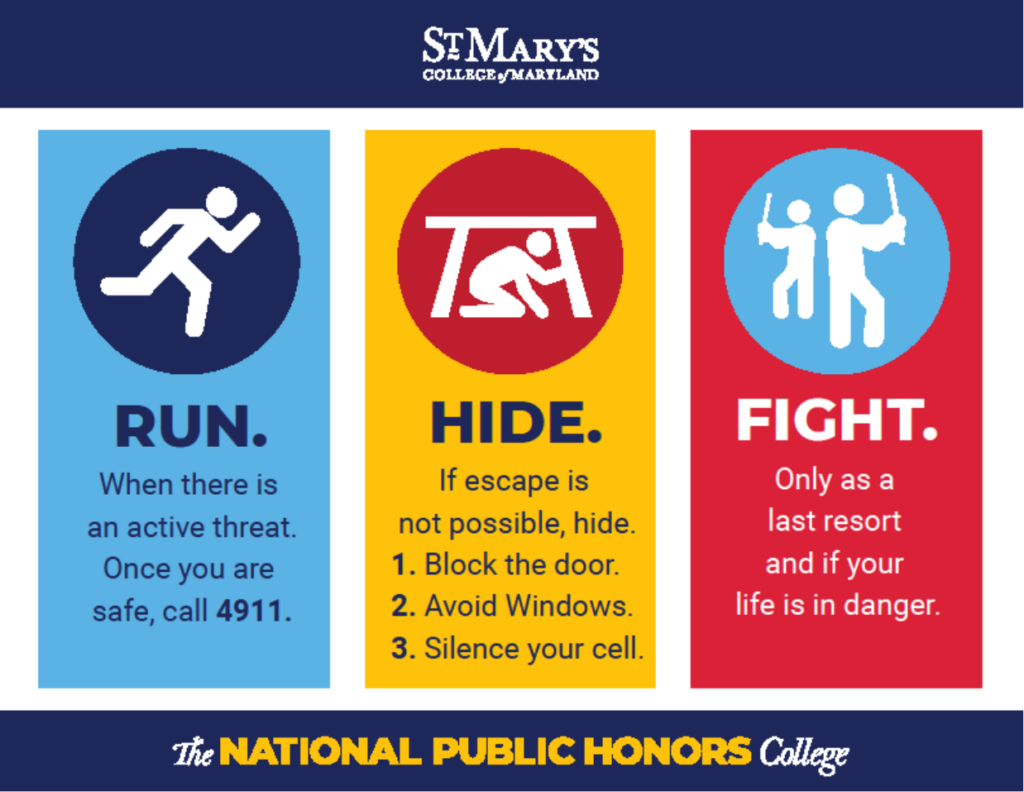An Active Shooter is an individual actively engaged in killing or attempting to kill people in a confined and populated area; in most cases, active shooters use firearms(s) and there is no pattern or method to their selection of victims.
Active shooter situations are unpredictable and evolve quickly. Typically, the immediate deployment of law enforcement is required to stop the shooting and mitigate harm to victims.
Because active shooter situations are often over within 10 to 15 minutes, before law enforcement arrives on the scene, individuals must be prepared both mentally and physically to deal with an active shooter situation.
If you hear shots fired on campus or if you witness an armed person shooting or threatening people (active shooter):
Immediately choose the best way to protect your life. Very quickly, make your best determination of what is occurring and which of the options below will provide the greatest degree of security for you employing the “RUN, HIDE, or FIGHT” protocol.
https://www.fbi.gov/how-we-can-help-you/safety-resources/active-shooter-safety-resources
RUN: Evacuate If Possible
- If there is considerable distance between you and the gunfire/armed person, quickly move away from the sound of the gunfire/armed person. If the gunfire/armed person is in your building and it is safe to do so, run out of the building and move far away until you are in a secure place to hide.
- Leave your belongings behind.
- Keep your hands visible to law enforcement.
- Take others with you, but do not stay behind because others will not go.
- Call 911 when it is safe to do so. Do not assume that someone else has reported the incident. The information that you are able to provide law enforcement may be critical, e.g. number of shooters, physical description and identification, number and type(s) of weapons, and location of the shooter.
HIDE: Hide silently in as safe a place as possible
- If the shooter is in close proximity and you cannot evacuate safely, hide in an area out of the armed person’s view.
- Choose a hiding place with thicker walls and fewer windows, if possible.
- Lock doors and barricade with furniture, if possible.
- Turn off lights
- Silence phones and turn off other electronics.
- Close windows, shades and blinds, and avoid being seen from outside the room, if possible.
- If you are outdoors and cannot RUN safely, find a place to hide that will provide protection from gunfire such as a brick wall, large trees or buildings.
- Remain in place until you receive an “all clear” signal from Blackboard Connect.
FIGHT: Take action to disrupt or incapacitate the shooter
- As a last resort, fight. If you cannot evacuate or hide safely and only when your life is in imminent danger, take action.
- Attempt to incapacitate or disrupt the actions of the shooter.
- Act with physical aggression toward the shooter.
- Use items in your area such as fire extinguishers or chairs.
- Throw items at the shooter if possible.
- Call 911 when it is safe to do so.
Immediately after an incident:
- Wait for Local Law Enforcement officers to assist you out of the building, if inside.
- When law enforcement arrives, students and employees must display empty hands with open palms.
Note:
- Understand that gunfire may sound artificial. Assume that any popping sound is gunfire.
- If there are two or more persons in the same place when a violent incident begins, you should spread out in the room to avoid offering the aggressor an easy target.
- Be mindful that violent attacks can involve any type of weapon, not just a gun. Knives, blunt objects, physical force or explosives can be just as deadly as a gun. The suggested actions provided here are applicable in any violent encounter.
- Plan ahead: Visualize possible escape routes, including physically accessible routes for students and staff with disabilities and others with limited mobility.

